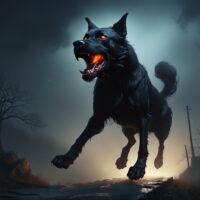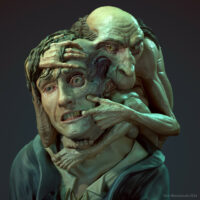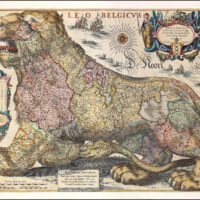Aufhocker : The Spirit of Burden
Listen
At a glance
| Description | |
|---|---|
| Origin | Germanic Mythology |
| Classification | Spirits |
| Family Members | N/A |
| Region | Germany |
| Associated With | Shapeshifting |
Aufhocker
Introduction
The Aufhocker is a sinister figure from Germanic folklore whose very name means “one who jumps on.” Tales describe it as a supernatural predator lurking on lonely roads, dark forest paths, and misty crossroads, waiting for the perfect moment to leap onto an unsuspecting victim’s back. Once attached, it grows unbearably heavy, crushing the strength out of its prey until they collapse. The Aufhocker is more than a frightening monster—it is a folkloric embodiment of guilt, fear, and inescapable burdens. In rural traditions, it often targeted wrongdoers such as thieves or criminals, punishing them for their actions, though stories also speak of it harassing lone travellers or the elderly. This blend of menace and moral lesson has kept the legend alive for centuries, giving the Aufhocker a unique place among Europe’s supernatural beings.
Physical Traits
The appearance of the Aufhocker is notoriously inconsistent, reinforcing its reputation as a shapeshifter. Some versions describe it as a hulking, goblin-like creature with distorted human features, while others portray it as a shadowy figure whose form is difficult to perceive. In many accounts, it manifests as a massive black dog with gleaming eyes and a predatory stance, linking it to the wider European “black dog” mythos. Other tales give it the body of a wolf, the face of a weary old woman, or the unsettling form of a walking corpse.
One of its most disturbing traits is its ability to manipulate its own weight. The longer it clings to its victim, the heavier it becomes, making forward movement almost impossible. In some regions, it is said to appear as a weary traveller or even a wounded animal, luring compassionate passers-by closer before revealing its true, oppressive nature. The Aufhocker’s predatory power lies not in speed or ferocity alone, but in the slow, suffocating dread it induces as its victim realises escape is nearly impossible.
Family
Unlike many mythological beings that belong to well-defined divine or demonic lineages, the Aufhocker is largely a solitary entity in folklore. It has no mythic relatives in the way gods or spirits might be connected through familial ties. However, it shares thematic similarities with a range of nocturnal predators and supernatural “burden spirits” found across Europe. In cultural terms, its closest “kin” are those creatures whose very existence revolves around oppression, paralysis, and psychological torment.
Germanic mythology often places such beings within a vast, morally complex world where supernatural forces interact with human fate. While the Aufhocker is not explicitly tied to cosmic creation myths or the gods’ struggles, it occupies a symbolic role—an agent of justice, punishment, or fear that reminds mortals of their vulnerability. Its isolation from a defined family tree may in fact heighten its mystery, making it feel like an unpredictable, rogue force within the folkloric landscape.
Other names
The Aufhocker appears under various names across Germany and neighbouring regions, each reflecting local language and cultural nuance. In northern Germany, it is often called Huckup or Huckupp, names that mimic the sound of something suddenly springing upon a person. In parts of Luxembourg and Limburg, similar back-riding creatures are known as Huckauf or linked to werewolf legends. The term Pudel has also been associated with it, drawing on the image of a dog-like form.
In Sorbian folklore, it is referred to as Bubak, a name tied to fearsome, lurking spirits. Some accounts use the plain description “back rider,” capturing the creature’s primary behaviour rather than a specific identity. The Belgian Kludde, a hellhound with the same stalking and pouncing behaviour, is often compared to the Aufhocker, suggesting a shared narrative thread across regional traditions. These alternate names highlight how the same core idea—a supernatural oppressor leaping onto victims—has been interpreted differently in various local cultures.
Powers and Abilities
The Aufhocker’s abilities make it a uniquely terrifying presence in folklore. Chief among these is its mastery of shapeshifting, or therianthropy, allowing it to assume animal or human forms at will. This talent enables it to deceive, ambush, and terrorise without warning. It can appear as an injured dog begging for help, a frail old woman seeking assistance, or a monstrous black wolf ready to pounce.
Its most feared ability is weight manipulation. Once it attaches to its victim’s back, it grows progressively heavier until the person is either immobilised or crushed. This unnatural pressure often forces victims to their knees or causes them to collapse entirely. Some versions of the legend claim the Aufhocker is vampiric, tearing at its victim’s throat to drink blood.
Despite its power, the creature is not entirely unstoppable. Folklore says it cannot be killed, but it can be driven away. Church bells, morning sunlight, fervent prayer, and even intense swearing are believed to break its hold. These weaknesses reflect a common theme in European myth—that darkness, no matter how oppressive, can be dispelled by light, faith, or sheer defiance.
Modern Day Influence
While the Aufhocker is less famous than vampires or werewolves, it continues to cast a shadow over modern storytelling. In German towns such as Hildesheim, statues like the Huckup monument serve as public reminders of the legend, blending local history with mythic imagery. Its symbolism has found a place in literature, music, and gaming, often reinterpreted as a metaphor for invisible burdens, whether emotional, psychological, or societal.
In literature, echoes of the Aufhocker appear in works dealing with oppressive forces or unseen pursuers, such as Goethe’s Der Erlkönig. Musicians have drawn on its imagery, with some German rock and metal bands invoking the creature in lyrics about inescapable fear. In video games such as The Witcher 3 and Bloodborne, creatures with clear Aufhocker-like traits—shapeshifting predators that ambush and drain the life from victims—pay homage to this old terror.
Psychologists and folklorists alike have noted the creature’s symbolic resonance. It mirrors the experience of carrying invisible weight, such as guilt, depression, or trauma—burdens that grow heavier the longer they are carried. This metaphorical interpretation ensures the Aufhocker remains relevant even outside traditional folklore, bridging the gap between ancient superstition and modern mental health discourse.
Today, the Aufhocker stands as a haunting emblem of the things that cling to us, unseen but relentless. Whether envisioned as a hellhound, a spectral rider, or a vampiric shapeshifter, it endures because it speaks to a universal truth: some burdens cannot be ignored, only confronted.
Related Images
Source
D. Wachsmuth. (n.d.). Folklore Bestiary – Aufhocker Bust. Retrieved from https://dirkwachsmuth.artstation.com/projects/040w08
Magical Gains. (2012, October 18). Dark Beasts of Germanic myth…. Retrieved from https://magicalgains.blogspot.com/2012/10/dark-beasts-of-germanic-myth.html
Mythical Encyclopedia. (n.d.). Aufhocker: What it is and What You Need to Know. Retrieved from https://mythicalencyclopedia.com/aufhocker/
Ronel the Mythmaker. (2022, November 11). Aufhocker: The Leaping Black Dog #folklore. Retrieved from https://www.ronelthemythmaker.com/aufhocker-folklore/
RTL. (n.d.). Wrestling with invisible attackers in the Mullerthal region – time …. Retrieved from https://www.rtl.lu/culture/film-and-books/a/1425424.html
The Arcana Wiki. (n.d.). Aufhocker – The Arcana Wiki. Retrieved from http://arcana.wikidot.com/aufhocker
Wikipedia. (n.d.). Aufhocker – Wikipedia. Retrieved from https://en.wikipedia.org/wiki/Aufhocker
Frequently Asked Questions
What is lorem Ipsum?
I am text block. Click edit button to change this text. Lorem ipsum dolor sit amet, consectetur adipiscing elit. Ut elit tellus, luctus nec ullamcorper mattis, pulvinar dapibus leo.
What is lorem Ipsum?
I am text block. Click edit button to change this text. Lorem ipsum dolor sit amet, consectetur adipiscing elit. Ut elit tellus, luctus nec ullamcorper mattis, pulvinar dapibus leo.
What is lorem Ipsum?
I am text block. Click edit button to change this text. Lorem ipsum dolor sit amet, consectetur adipiscing elit. Ut elit tellus, luctus nec ullamcorper mattis, pulvinar dapibus leo.
What is lorem Ipsum?
I am text block. Click edit button to change this text. Lorem ipsum dolor sit amet, consectetur adipiscing elit. Ut elit tellus, luctus nec ullamcorper mattis, pulvinar dapibus leo.
What is lorem Ipsum?
I am text block. Click edit button to change this text. Lorem ipsum dolor sit amet, consectetur adipiscing elit. Ut elit tellus, luctus nec ullamcorper mattis, pulvinar dapibus leo.









